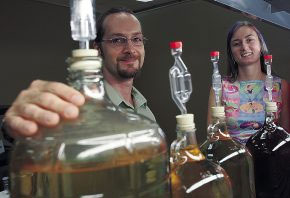A U.S. company might have found a way to optimize wind energy harvests. Officials with Sky WindPower Corporation believe that by elevating their wind generators to high altitudes, they can harvest the energy of the much stronger high-altitude winds.
 This story from CNN.com says the picture on the right is an artist’s rendering of what such a generator would look like:
This story from CNN.com says the picture on the right is an artist’s rendering of what such a generator would look like:
And the madcap gadget that might just provide a solution? A helicopter that doubles as a wind turbine. Or, to give it its technical name, a FEG (Flying Electric Generator).
The brainchild of Australian engineering specialist Professor Bryan Roberts, the FEG is being developed by San Diego-based company SkyWindPower.
The guiding principle of the FEG is that wind speed and constancy are far greater at high altitude than they are on the ground, especially in the two major jet streams – the Sub-Tropical Jet and the Polar Front Jet – that exist in each hemisphere (at around 30 degrees and 60 degrees latitude respectively).
A turbine at great height, so the theory goes, can generate far more power than a similar turbine at or near ground level. It has been estimated that capturing just one percent of the available energy of these high altitude winds would meet the electricity needs of the entire planet.
Company officials believe the high-flying generators could produce 20 megawatts of electricity… compared to just five megawatts for the average for more land-based wind turbines now.


 In an effort to get back on the road, Shared Route… a colorful, biodiesel bus that runs between Portland, Oregon and Olympia and Seattle, Washington… will run on vegetable oil.
In an effort to get back on the road, Shared Route… a colorful, biodiesel bus that runs between Portland, Oregon and Olympia and Seattle, Washington… will run on vegetable oil. “I understand it’s an uphill battle, and I’m going to stay in the fight,” said ITAC Engineers & Constructors Senior Vice President Rick Starnes, a key player in the project who spent more than 20 hours last week walking Brentwood to discuss the plant with residents. “I wouldn’t work this hard if I didn’t think this was the right project for this area.”
“I understand it’s an uphill battle, and I’m going to stay in the fight,” said ITAC Engineers & Constructors Senior Vice President Rick Starnes, a key player in the project who spent more than 20 hours last week walking Brentwood to discuss the plant with residents. “I wouldn’t work this hard if I didn’t think this was the right project for this area.”

 The exective director of the
The exective director of the  Blume, who sounds like one pretty interesting character, is the author of a soon-to-be-released book called “Alcohol Can Be A Gas,” subtitled Fueling an Ethanol Revolution for the 21st Century.
Blume, who sounds like one pretty interesting character, is the author of a soon-to-be-released book called “Alcohol Can Be A Gas,” subtitled Fueling an Ethanol Revolution for the 21st Century.  The
The  NEVC Executive Director Phil Lampert says these include some of the most popular vehicle models. “From a humble beginning of less than 500 FFVs in 1993, we expect that more than 750,000 such FFVs will be produced in the coming year,” he said.
NEVC Executive Director Phil Lampert says these include some of the most popular vehicle models. “From a humble beginning of less than 500 FFVs in 1993, we expect that more than 750,000 such FFVs will be produced in the coming year,” he said. Metro Transit… the public transportation service for the Minneapolis-St. Paul metro area… is raising the amount of biodiesel it is using in its vehicles to a 10% blend. For the last 14 months, Metro Transit has been using a 5% blend.
Metro Transit… the public transportation service for the Minneapolis-St. Paul metro area… is raising the amount of biodiesel it is using in its vehicles to a 10% blend. For the last 14 months, Metro Transit has been using a 5% blend.
 The Iowa Biodiesel Board and Iowa Soybean Association, along with the commercial biodiesel maker and biodiesel plant maker, Renewable Energy Group are offering a series of biodiesel management seminars in different parts of the state.
The Iowa Biodiesel Board and Iowa Soybean Association, along with the commercial biodiesel maker and biodiesel plant maker, Renewable Energy Group are offering a series of biodiesel management seminars in different parts of the state.